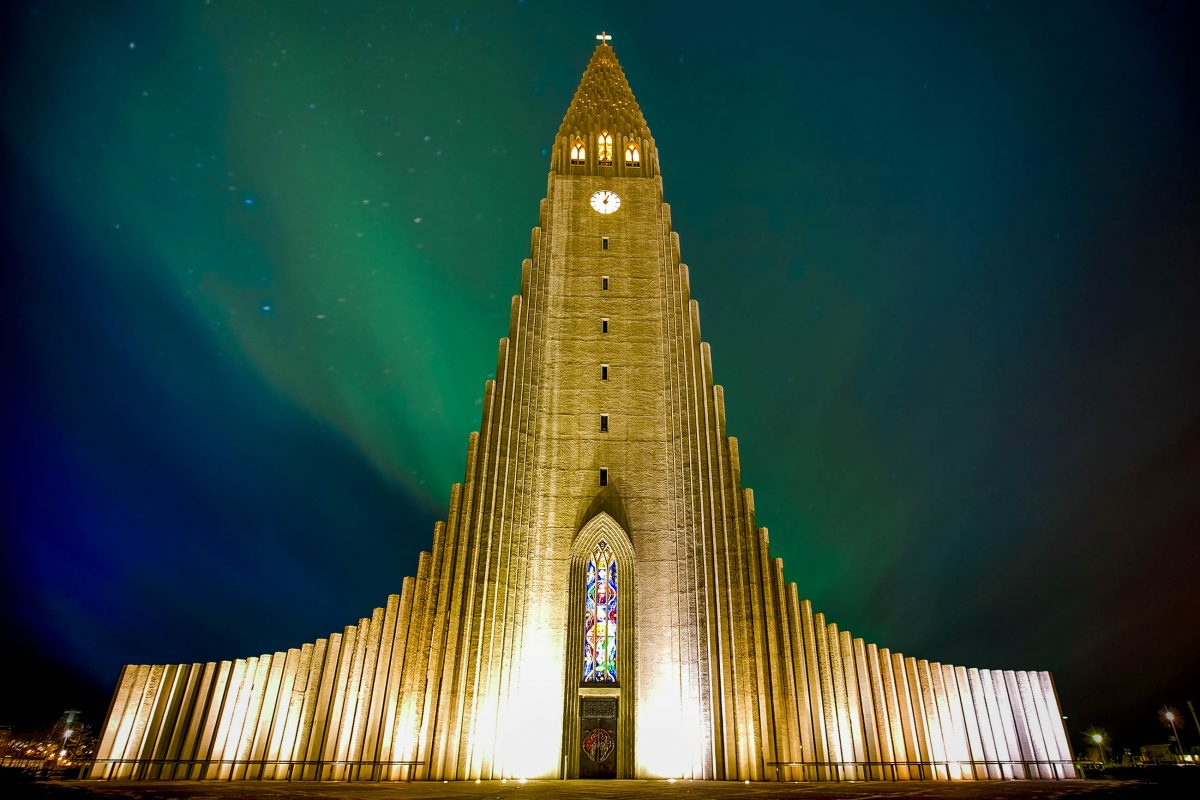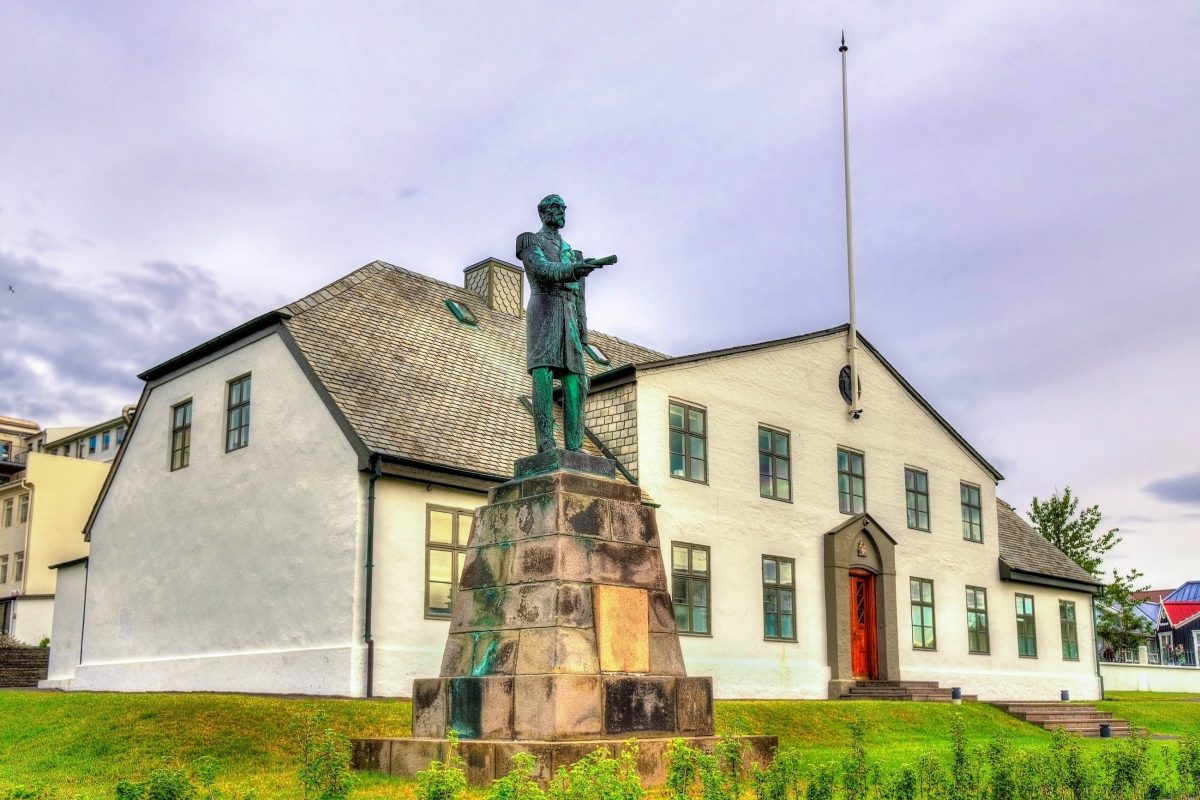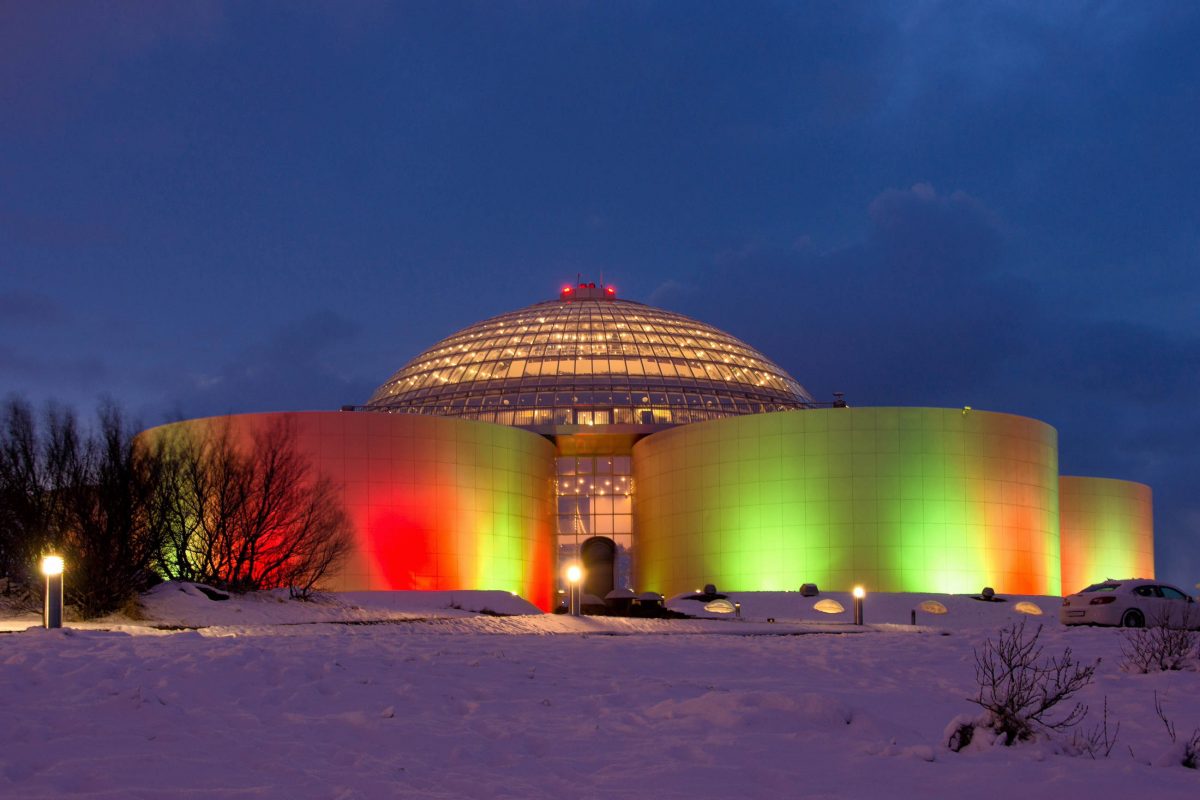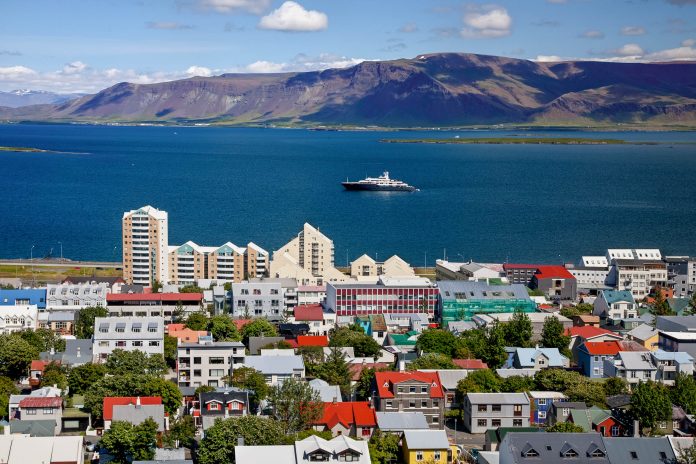Reykjavik, die Hauptstadt Islands, offenbart ihre Sehenswürdigkeiten erst auf den zweiten Blick. Doch dann gibt es heiße Quellen, farbenprächtige Häuser, imposante Kirchen und futuristische Neubauten.
In Reykjavík leben knapp zwei Drittel der Einwohner Islands, dennoch ist die nördlichste Hauptstadt der Welt auch eine der bevölkerungsärmsten. Die vergleichsweise kleine Stadt kann ohne Probleme zu Fuß erkundet werden.
Im wirtschaftlichen, politischen und kulturellen Zentrum Islands wirkt die Atmosphäre auf den ersten Blick etwas kühl, der Charme der Hauptstadt erschließt sich dem Besucher erst nach genauerem Hinsehen. Dann entpuppt sich die „Rauchbucht“ als weltoffenes, historisch und kulturell wertvolles Kleinod, das zu unseren Top 10 Sehenswürdigkeiten von Island gehört.
Inhaltsverzeichnis
Kirche Hallgrimskirkja

Das Wahrzeichen von Reykjavík ist die weithin sichtbare Kirche Hallgrimskirkja, die unübersehbar auf einem Hügel der Stadt thront. Das ebenso imposant wie modern gestaltete Gotteshaus wurde im Jahr 1986 nach 43 Jahren Bauzeit eingeweiht. Der 73m hohe Turm der Kirche ist fast von jedem Punkt in Reykjavík zu sehen. Sein Design erinnert unweigerlich an einen Wasserfall, die die Landschaft Islands so zahlreich zu bieten hat.
Gegen eine kleine Gebühr bringt ein Lift die Besucher auf die Spitze des interessant gestalteten Turms, von wo aus sich ein überwältigender Rundblick auf Reykjavík auftut. Die ausgezeichnete Akustik in der Hallgrimskirkja wird immer wieder für klassische Konzerte genutzt. Gottesdienste werden jeden Sonntag Vormittag abgehalten.
Die Kathedrale Dómkirkjan
Die gegen die Hallgrimskirkja eher einfache gehaltene Kathedrale Dómkirkjan wurde 1787 erbaut und befindet sich direkt im Zentrum der Altstadt. Sie war ursprünglich das religiöse Zentrum des Landes. Damals fanden noch fast alle Einwohner Reykjavíks Platz in der Kathedrale. Sie ist Montag bis Freitag geöffnet und befindet sich direkt am Austurvöllur, dem bedeutendsten Platz von Reykjavik. Hier treffen sich die Isländer, um zu feiern, bei nationalen Kundgebungen oder einfach nur, um sich die Mitternachtssonne auf den Bauch seinen zu lassen.
Altstadt von Reykjavík

Rund um die Kathedrale lohnt es sich auch gleich, das Altstadtviertel zu erkunden. Neben den farbenfrohen und teils historischen Häusern, Outdoor-Bekleidungs-Shops und kleinen aber finden Boutiquen sind insbesondere folgende Straßen und Viertel einen Abstecher wert:
- Die „Wasserstraße“ Laugavegur, die älteste Straße Reykjaviks führt vom Stadtpark Laugardalur bis zur Bankastræti.
- Skolavordustigur verbindet Laugavegur mit der Kirche Hallgrimskirkja und ist die klassische Flaniermeile von Reykjavik mit interessanten Shops, Restaurants und Bars.
- Laekjargata mit dem gleichnamigen Platz inklusive Touristeninformation und vielen historischen Bauten. Mit ihren bunten Farben auch als „Regenbogenstraße“ oder „Bifröst“ (die Straße in die mythologische Götter-Stadt Asgard) bekannt, findet hier das jährliche Gay Pride Festival am zweiten August-Wochenende statt. Außerdem befindet sich hier mit dem 1796 errichteten Haus des Premierministers, dem Stjornarradid, eines der ältesten Steingebäude der Stadt.
- Die Fußgängern vorbehaltene Austurstraeti ist nicht so berühmt wie die vorhergehend und präsentiert das quirlige Leben der Einheimischen.
- Die Straßen im Stadtviertel Thingholtin zwischen der Hallgrimskirkja und dem städtischen See Tjörnin tragen im „Viertel der Götter“ Namen aus der nordischen Mythologie. Verziert von Street Art sind hier unter anderm Thor, Odin, Loki und Freya vertreten.
Stadtsee Tjörnin

Auch Reykjaviks See ist eine äußerst beliebte Sehenswürdigkeit! Direkt am von Schwänen und Enten bevölkerten Stadtsee befinden sich das Rathaus von Reykjavik, das markant dunkel gefärbte Parlament, die isländische Universität und das Nordische Haus. Letzteres ist das einzige Gebäude der Stadt, welches von einem international bekannten Architekten entworfen wurde (dem finnischen Alvar Aalto) und fungiert als Kulturzentrum und nettem Café mit Blick über den See.
Konzerthaus Harpa

Das äußerst modern gestaltete Konzerthaus Harpa liegt direkt am Hafen und wurde 2011 eröffnet. Der gewaltige gläserne Bau fungiert als Opern- und Konzerthaus der Hauptstadt. Im Inneren befindet sich ein großer Konzertsaal für 1.800 Besucher, sowie drei kleinere Konzerträume.
Als Besonderheit ist zu erwähnen, dass mit Hilfe eines vollautomatischen Systems die Akustik der Räume für jede Art von Musik optimal eingestellt werden kann. Zusätzlich zu seiner Funktion als Konzerthaus fungiert das Harpa auch als Konferenzzentrum.
Der Warmwasserspeicher Perlan

Südlich des Stadtzentrums von Reykjavík befindet sich der Warmwasserspeicher Perlan mit einer gewaltigen Glaskuppel. Er wurde 1991 fertiggestellt und versorgt die gesamte Stadt mit heißem Wasser. In fünf Tanks befinden sich jeweils bis zu vier Millionen Liter Wasser mit einer Temperatur von 85°C, die von hier aus in der Stadt verteilt werden.
Durch seine Lage auf dem Hügel sind dafür keine Pumpen notwendig. Im Winter werden mit dem warmen Wasser aus den Perlan Tanks sogar die Gehwege und Straßen von Reykjavík beheizt und damit eisfrei gehalten.
Am Dach befindet sich eine Aussichtsplattform, die neben einem fantastischen Rundblick auch ein Drehrestaurant und den faszinierenden Sonnenkompass zu bieten hat. Außerdem ist hier das Museum der Naturwunder Islands zu finden.
Geothermischer Badestrand in der Nautholsvik Bucht
Für die meisten Touristen ist Islands Klima für ein Bad im Meer immer zu kalt. Die Tageshöchsttemperaturen im Sommer steigen selten auf 20°C, das Meer lädt mit rund 10°C auch nicht gerade zum Schwimmen ein. Nicht so in der Nautholsvik Bucht! Hier verbreitet eine künstliche Lagune mit goldgelbem Sand ein bisschen Strandurlaubs-Atmosphäre.
Durch heißes Geothermalwasser das in die künstliche Lagune eingeleitet wird, erhöht sich die Wassertemperatur im Sommer auf 15°- 19°C. Noch immer zu kalt? Die „Hot Tub“ vor dem Service Center bringt es mit 38°C auf echte Badewannen-Temperatur. Der Strand ist von Mitte Mai bis Mitte August tagsüber geöffnet, der Eintritt ist frei.
Tipp: Wer in Island baden möchte hält sich am besten an die angenehm temperierten und noch dazu heilsamen Thermalbäder in der Blauen Lagune. Auch Reykjaviks öffentliche Freibäder verfügen zu hundert Prozent über beheiztes Wasser und gleichen schon eher einem Spa, als einem Schwimmbad.
Freizeitzentrum Laugardalur
Auch hier gibt es ein beheiztes Schwimmbad und daneben noch zahlreiche andere Attraktionen. Dazu gehören zum Beispiele eine Sporthalle, Islands größtes Schwimmbecken, eine Eisbahn, ein Mini-Golf-Platz, ein Botanischer Garten, ein Zoo und ein Skulpturenmuseum. Mit der Reykjavík City Card ist der Eintritt übrigens frei.
Museen von Reykjavik
- Das Nationalmuseum präsentiert überwiegend Sammelstücke isländischer Kultur (Waffen, Gebrauchsgegenstände, Schmuck, etc.)
- Die Nationalgalerie stellt in einer umfassenden Sammlung die bedeutendsten isländischen Künstler vor.
- Im Freilichtmuseum Árbæjarsafn kann anhand von 30 Torfhütten und Wohnhäusern inkl. Innenausstattung das isländische Leben von damals nachvollzogen werden.
- Das Ásmundur-Sveinsson-Skulpturenmuseum im Freizeitzentrum Laugardalur zeigt Werke des Künstlers Ásmundur Sveinssons (1893-1982) in einem einzigartigem Gebäude aus den 30er Jahren. Um das Haus herum gibt es einen eindrucksvollen Skulpturengarten.
- Neben der Kirche Hallgrimskirkja befindet sich mit dem Einar Jónsson Museum das zweite große Skulpturenmuseum Reykjaviks.
- Die „Whales of Iceland Exhibition“ am Alten Hafen ist das größte Walmuseum der Welt und beeindruckt Groß und Klein mit ihren lebensgroßen Exemplaren der über 20 Walarten, die rund um Island leben.
- Aurora Reykjavík ist das Museum der Nordlichter. Live ist das unvergessliche Himmels-Spektakel übrigens am besten zwischen Oktober und März zu beobachten.
- Im Phallologischen Museum – der wohl skurrilsten Sehenswürdigkeit Reykjaviks – sind männliche Geschlechtsteile aus verschiedensten Teilen der Welt und von den unterschiedlichsten Spezies zu sehen.
Sun Voyager

Diese Skulptur an der Hafenpromenade befindet sich ganz in der Nähe des Harpa Konzerthauses und gilt neben der als meistfotografierte Sehenswürdigkeit von Reykjavik. Das rudimentäre Wikingerschiff wurde 1990 nach der 200-Jahr-Feier von Reykjavik errichtet. Entlang der Promenade lohnt sich außerdem eine kurze Pause in einem der zahlreichen Restaurants.
Schach: Das Match des Jahrhunderts
Unter enormem Medieninteresse fand am Höhepunkt des kalten Krieges 1972 in Reykjavík das sogenannte Match des Jahrhunderts zwischen dem amtierenden Schachweltmeister Boris Spasski und dem amerikanischen Herausforderer Bobby Fischer statt. Nach 21 gespielten Partien, errang Fischer den Weltmeistertitel, den seit dem Ende des zweiten Weltkrieges immer die damalige Sowjetunion gehalten hatte.
Skurril: Nach einer Neuauflage des Spiels 20 Jahre später während des Jugoslawienkriegs – Fischer siegte wieder – wurde Fischer anschließend wegen Verstoß gegen das Jugoslawien-Embargo von den amerikanischen Behörden gesucht. Nach einer mehrjährigen Flucht Fischers wurde er letztendlich in Japan verhaftet und erhielt 2005 Asyl in Island. Hier starb er auch 2008.
BILDER: Die Top 10 Sehenswürdigkeiten von Reykjavik
Fotogalerie: Die Top 10 Sehenswürdigkeiten von Reykjavík
Weiterführende Links:
Offizielle Tourismus-Webseite von Reykjavík
Infos zur Rekjavík City Card





